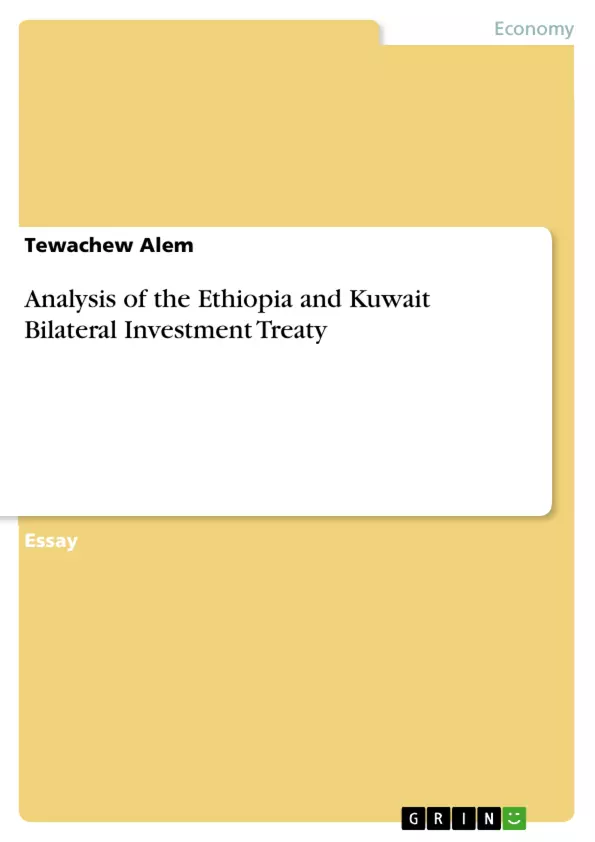The treaty type which is subject to this analysis is a bilateral investment treaty made between Ethiopia and Kuwait (here in after contracting parties), which is signed 14/09/1996 and entered into force 12/11/1998. The author analyzed the treaty beginning from preamble to provision of duration and termination.
Inhaltsverzeichnis (Table of Contents)
- I. Introduction
- II. Body Part
- A. Preamble
- B. Scope and Definition
- C. Treatment of Investments
- D. Protection of Investments
- E. Expropriation
- F. Transfer of Related to Investments
- G. Other Clauses
- H. Settlement of Disputes
- I. Institutional issues
- J. Treaty Duration, Amendment and Termination
- III. Conclusion
Zielsetzung und Themenschwerpunkte (Objectives and Key Themes)
This analysis examines the Ethiopia-Kuwait Bilateral Investment Treaty, signed in 1996 and entered into force in 1998. It focuses on the treaty's provisions, analyzing its strengths and weaknesses in the context of international investment law.
- Protection of investments and the fair and equitable treatment standard
- Expropriation and compensation provisions
- Transfer of funds and limitations on the obligation
- Investor-State Dispute Settlement (ISDS) mechanisms
- Critique of the treaty's silence on specific issues like environmental and labor standards.
Zusammenfassung der Kapitel (Chapter Summaries)
- I. Introduction: This chapter provides an overview of the treaty, including its date of signing and entry into force.
- II. Body Part: This section offers a detailed examination of the treaty's provisions, from the preamble to the provisions on treaty duration, amendment, and termination.
- A. Preamble: The preamble outlines the treaty's objectives, focusing on promoting economic cooperation between Ethiopia and Kuwait and encouraging investments. The chapter also highlights criticisms of the preamble's lack of reference to certain critical issues like sustainable development, social investment aspects, and environmental concerns.
- B. Scope and Definition: This chapter analyzes the definitions of "investment" and "investor" provided in the treaty. It examines the strengths and limitations of these definitions, including the lack of exclusion of portfolio investments, the requirement of compliance with host state laws, and the absence of a comprehensive list of covered assets. The chapter also discusses the lack of a denial of benefits clause and the absence of a substantial business activity requirement for legal entities.
- C. Treatment of Investments: This chapter examines the treaty's provisions regarding the treatment of investments. It emphasizes the obligation of each contracting state to ensure fair and equitable treatment of investments, including most favored nation treatment (MFN) and national treatment (NT). The chapter also discusses the unqualified nature of the fair and equitable treatment (FET) standard, which is not qualified by reference to international law or by listing FET elements.
- D. Protection of Investments: This chapter analyzes the treaty's provisions regarding the protection of investments. It highlights the standard prohibition of unreasonable, arbitrary, or discriminatory measures and the requirement for full protection and security of investments in accordance with recognized principles of international law.
- E. Expropriation: This chapter examines the treaty's provisions on expropriation, nationalization, dispossession, and indirect measures having equivalent effects. It emphasizes the requirement of public purpose and the payment of prompt, adequate, and effective compensation on a non-discriminatory basis. The chapter also highlights the provision's strengths and critiques, including the absence of a clear definition of indirect expropriation.
- F. Transfer of Related to Investments: This chapter examines the treaty's provisions regarding the free transfer of payments related to investments. It highlights the obligation of each contracting state to guarantee the free transfer of funds related to investments, but also notes the absence of specific exceptions to this obligation, such as balance-of-payments (BOP) exceptions.
- G. Other Clauses: This chapter delves into various other clauses of the treaty, including transparency obligations, health and environmental provisions, labor standards, corporate social responsibility, corruption, and investment promotion activities. It identifies the lack of specific provisions on these issues within the treaty text.
- H. Settlement of Disputes: This chapter explores the treaty's provisions on dispute settlement mechanisms, focusing on both contracting state-to-state disputes (SSDS) and investor-state disputes (ISDS). It examines the provisions for amicable settlement and the provisions for investor-state dispute settlement (ISDS) under Article 9, emphasizing the importance of reaching amicable solutions if possible. The chapter also briefly mentions Article 10, which likely covers contracting state-to-state disputes.
Schlüsselwörter (Keywords)
This analysis focuses on key concepts within international investment law, including bilateral investment treaties (BITs), fair and equitable treatment (FET), national treatment (NT), most favored nation treatment (MFN), expropriation, transfer of funds, investor-state dispute settlement (ISDS), and sustainable development.
- Arbeit zitieren
- Tewachew Alem (Autor:in), 2019, Analysis of the Ethiopia and Kuwait Bilateral Investment Treaty, München, GRIN Verlag, https://www.hausarbeiten.de/document/509392


